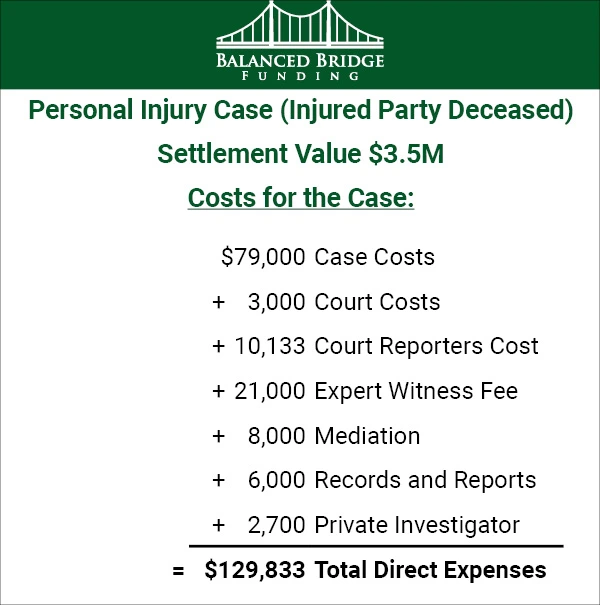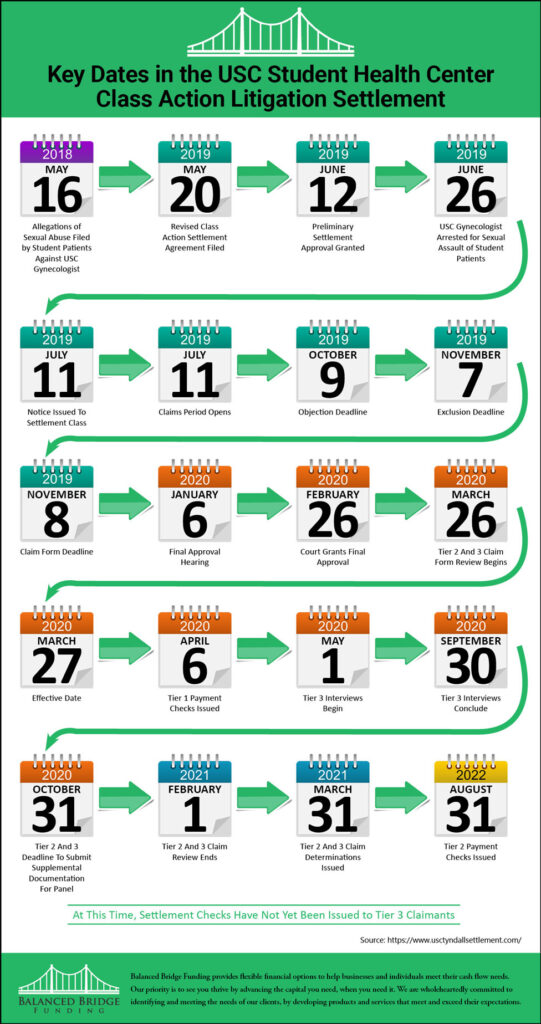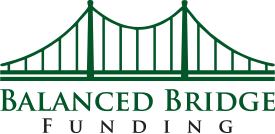Legal funding not just for smaller law firms – Large law firms leverage growth
Large Law firms use post settlement funding to leverage growth. By being able to gain quick access to the attorney fees they are owed from cases (won or settled), they can keep their cash working for them to leverage future growth. Large law firms have discovered that the faster they can collect their contingency fees, the faster they can put it back to work financing their strategic growth plans.
There was a time when post settlement funding was seen as a finance instrument primarily for small law firms. This way of thinking was so pervasive that larger law firms kept their use of legal funding very quiet. They were afraid their use of legal funding might make them appear financially unstable and impact their reputations. At legal industry trade show events, partners of large law firms were sometimes seen quickly grabbing business cards from the booths of legal funding companies and then quickly walking away so they would not be seen.
But over time, large law firms began to see the benefits of using legal funding. Post settlement funding allowed them to get some of their contingency fees in the bank right away instead of waiting months (or years) for defendants to pay the money they owed. With that money, large law firms could pay bills, pay salaries, fund marketing campaigns, invest in new technology, and hire/recruit top talent.
Many large law firms have been making use of pre-settlement funding to fund their plaintiff work. These firms may be taking on thousands of cases in an MDL for many different clients. Pre-settlement funding allows law firms to take on financing before a case has even begun. But pre-settlement funding is expensive. Often it is a scenario where the funder gets a multiple of whatever money they loaned out. As an example, if they loan five million, maybe they get a 2x multiple and get $10 million back.
Post-settlement, however, can be attained much cheaper than pre-settlement transactions. Many of these larger scale cases will have months of delays until the law firm contingency fees will be distributed to them after the settlement has been reached. Making use of post-settlement funding can help large law firms refinance out of higher cost legal funding or just to save some money over these pre-settlement deals.
It is common to hear people say, “Time is money.” But what does this really mean? In the business world what it means is lost time equals missed opportunities. Every moment you spend waiting to get paid, you are not marketing, recruiting, investing in technology, etc., and you can never get that time back. It is lost, as are any opportunities you might have had while you were waiting on your money.
Once a case concludes, and a judgment is ordered, you should be taking out a post settlement advance right away to get that money into your cash account so you can execute your future growth initiatives.
Gary Vaynerchuk (Gary Vee), the media mogul and marketing/motivational speaker was talking (in a video clip) about financing mistakes he had made when it came to the growth of Vaynerchuk Media.
He said something like this: “Every month I saw that bill come in for sixty, seventy, eighty thousand dollars for our Google Ads, and it freaked me out. I just kept seeing all that money going out every month and it bothered me. So, I decided to try and cut it down as much as possible. And you know what? I was so wrong. So wrong. I was thinking about it the wrong way. Instead of trying to reduce my ad spend, I should have been figuring out how to get my ad spend up to two million or three million dollars every month. And if I had, my business could have been where it is now three years ago.”
It doesn’t make sense for large law firms to be sitting around waiting to get paid for lawsuits they have won. Every moment spent waiting, just moves success that much further “down the road.” So instead of selling the law firm three years from now, maybe you’ll be selling it six years from now instead. Instead of being the number one law firm in your city, maybe you’ll be number four.
You need to get your contingency fees in your bank as fast as you can to get that money back in the game working for you. This is why large law firms have embraced using post settlement funding – to get at their contingency fees as quickly as possible so they can put it to work.
The Three Main Reasons Large Law Firms Use Post Settlement Funding
- Managing cash flow
- Paying Bills, partners, and employees
- Finance future growth
Reason #1: Using Post Settlement Funding for Managing Cash Flow
Businesspeople talk about cash flow a lot, but few of them truly understand what cash flow means, or how it works. Cash flow essentially describes two “flows” of cash.
The two “flows” of cash are cash flowing IN your bank account – and – cash flowing OUT of your bank account. This is all cash flow means.
If you have sufficient cash, or access to cash through credit cards, lines of credit, loans, private equity, legal funding or other means to pay your bills and grow your law firm, then your cash flows are healthy. If you are constantly running low on cash to pay for these things, then your cash flows are not healthy.
When most people talk about cash flow, what they are describing is sales, and this is incorrect. It is important to not conflate sales (or profit) with cash flow. They are not the same thing. In fact, an increase in sales (getting a new client) will almost always result in a DECREASE in cash, not an increase. Sales hurt cash flow when they first come in. They only help cash flow once you collect the money, which, as you know, for plaintiff attorneys can take years.
It is also important to understand what cash is. As it pertains to financing activities for large law firms, cash does not necessarily mean literal cash, like cash in the bank. Cash can come from credit cards, loans, lines of credit, selling stock, private equity investments, and legal funding. It doesn’t matter where it comes from, if you can spend it, it is considered “cash” when we are talking about cash flow or cash flow management and business finance.
What is Cash Flow Management?
Cash flow management is any activity used to regulate these two flows of cash (cash flowing – cash flowing out).
The goal of cash flow management is to keep the money flowing into the account and make sure it doesn’t flow out faster than it comes in. Why? Because when your bank account is empty and you run out of borrowing power, you can’t pay bills or payroll, and when that happens, your business closes. It doesn’t matter if you have millions of dollars in contingency fees that are owed to you – if you can’t pay the rent, you get evicted from your office space.
This is why keeping your finger on the pulse of these two flows of cash is important. It is also why financing activities like using legal funding are important for law firms – it doesn’t matter where the money comes from, as long as it comes.
What are Cash Flow Problems?
Cash flow problems is the phrase used to describe a situation where your business is having trouble keeping enough cash (or cash equivalents like credit) to pay bills, pay employees, pay vendors, or pay for growth activities like marketing, or acquisitions.
What Causes Cash Flow Problems for Law Firms?
Cash flow problems for Law Firms are caused by the same things that cause cash flow problems for any type of business:
#1: Incurring massive expenses now, and not getting paid until much later for your work.
Lots of businesses have this type of cash flow challenge. They go out and get work, but performing that work creates costs to complete the work. This could be for parts, materials, labor, Etc.
If the company sales team does their job and deals get closed – then, someone must perform that work, and in many types of business (like Plaintiff Attorneys), you have to perform the work before you get paid for it. This “time gap” between incurring expenses to perform your work and getting paid for it creates cash flow problems.
This scenario perfectly describes plaintiff work. You have to spend a lot of money to win the case, but it can take years for a case to settle or conclude, and then you still have to wait months, or sometimes years, before you get paid your contingency fees. And while you are waiting to get paid, money keeps going out to keep the lawsuit going, to pay your bills, and to pay employees.
Plus, if you want to grow your law firm, you need to keep marketing and taking on even more cases, which creates an even larger cash flow challenge to solve.
The worst part is, you can’t solve this type of cash flow problem by getting more clients. In fact, more sales exacerbate these types of cash flow problems rather than solving them.
And in many cases, this is the precise reason a lot of small businesses stay small. It is hard for businesses to self-finance their growth when “winning” work ultimately means taking on major expenses and waiting a long time to get paid. They are constantly fluctuating between having lots of cash one moment and being on the edge of running out of money the next.
Plaintiff Work is Expensive and Causes Cash Flow Issues
Doing plaintiff work is expensive and becoming more expensive by the day. We have compiled a list of actual examples of costs incurred by law firms (below) illustrating the cost of reaching a settlement for their clients.
Class Action Product Liability Lawsuit – Settlement Value $90M
Costs: $600K in attorney costs which included process-server fees, filing fees and other court-related expenses, copy costs, expert fees, and consultant fees.
This case took five years to settle. The law firm incurred $600,000 in costs over that time. And these are just the costs associated with the case itself. During that time they still had to keep their law firm running, pay salaries, rent, Etc.
Personal Injury Case (Injured Party Deceased) – Settlement Value $3.5M

Costs For This Case:
- $79K case costs
- $3,000 court cost
- $10,132.98 for court reporters
- $21,000 for expert witness fee
- $8,000 for mediation
- $6,000 for records and reports
- $2,700 for a Private investigator
Total Direct Expenses: $129,832.98
And again, these are just some of the direct costs associated with taking on and winning this case. The law firm still had to operate their law firm until the case concluded and then wait even longer until the defendant paid what they owed. In large cases, defendants are sometimes allowed to pay over ten years. That is a long time to wait to get paid for your work.
California Class Action – Settlement Value $20M
- $6,000 deposition transcripts
- $61,000 electronic discovery services
- $509,000 expert services
- $32,000 settlement special master fees
- $770 miscellaneous
- $21,000 in other class counsel expenses
Total Expenses $632K
The Longer it Takes to Get Your Contingency Fees, The More Cash Flow Problems Increase
There is a lot that goes into determining the timeline from the completion of a legal case (or settlement). There is also a lot that goes into determining when everyone gets paid by the defendant. In small insurance settlements, a defendant might release funds in one month’s time. For larger settlements or class action settlements, it can take years (sometimes more than ten) before the defendant pays what they owe.
This case was another instance where the law firm incurred $600,000 in expenses directly related to the case and the case lasted for four years. Four years is a lot of time to be out of pocket half a million dollars and then wait for the defendant to pay once the case concludes.
Example: In the recent JUUL E-Cigarette maker class action lawsuit, JUUL was given the option of paying the settlement (almost $300 Million) over a period of ten years. Read more about the JUUL E-Cigarette maker class action suit.
Example: When USC settled their sexual assault class action lawsuit, USC was allowed to pay over the course of almost eighteen months, in spite of the fact that they had ample ability to pay what they owed at any time. Read more about the USC class action lawsuit settlement.

Read more about the USC class action lawsuit settlement.
So you see, it can take a long time to get paid from a settlement award or judgment once a lawsuit concludes.
If you’d like to learn more about how long it takes to get paid from a big case like a class action lawsuit settlement, read our article about how long it takes to get a check.
Why Cash Flow for Large Law Firms Matters
Businesses do not close because of lack of profit, or even lack of sales (although this may contribute to the problem). Businesses close their doors when they run out of cash because they can no longer pay employees and/or vendors. And this doesn’t just happen to small companies. Businesses ranging from major banks to trucking companies with tens of thousands of trucks in their fleet have suddenly closed their doors because they simply ran out of cash to pay employees, and vendors to continue operations. One day they were open, and the next day they closed their doors forever.
It doesn’t matter how big your company is. When you can’t pay bills and employees, you are out of the game. If you can pay bills, employees, and vendors, whether by taking out loans or selling stock, or using post settlement funding, you remain in business.

Some businesses have cash flows that are so constant and continuous, they never turn a profit but can stay in business perpetually. As an example, companies like Amazon and Uber rarely make a profit. But they stay in business because they have massive amounts of cash flowing into their bank account every minute of every day from around the world.
A company with that kind of constant inbound cash flow can go on indefinitely because they will ALWAYS have cash coming in every single day they can use to pay employees, bills, and vendors. They may occasionally overextend themselves and need to make layoffs or make some other cuts, but they will never be short of cash, so they will never close.
But big law firms’ cash flows are not like that at all. Large law firms may only get paid a few times per year from past cases they’ve won (or settled). Large plaintiff law firms can never be certain when they will get their next check. This “gap” between doing work and getting paid must be navigated carefully or a law firm can go bankrupt even though they are owed millions and have excellent looking balance sheets.
It doesn’t matter if a company has millions of dollars coming to them “soon.” You can’t pay bills with your receivables until you convert them to cash. When you can’t pay the rent or make payroll, your law firm will close its doors. This is why managing cash flow matters for big law firms.
Solving Cash Flow Problems for Major Law Firms
Remember the basic law firm cash flow problem: Money goes out constantly to cover the costs of litigating cases and comes in slow because you have to wait on the defendant to pay what they owe.
The solution to cash flow problems is to one, have access to sufficient capital whenever you need it to cover the time between getting work and getting paid, and two, to collect the money that is owed to you as quickly as you can.

We mentioned this in the introduction, but it is worth repeating – it doesn’t matter “where” the money comes from. As long as you have money (or credit) to pay bills, expert witnesses, marketing, salaries, and other expenses, you get to keep going.
The reason we bring this up is because most people tend to think of cash as typically coming from sales, but sales is just one way to get cash to pay for things. Companies sell stock to raise cash, they issue bonds to raise cash, they solicit private equity investors, they secure loans, get attorney lines of credit, and use business credit cards. They use pre-settlement funding to finance taking on cases, and they post settlement funding to get access to some of their contingency fees right away as opposed to waiting to get paid from the defendant.
Major law firms are catching on to the many financial vehicles they have available to them (including post settlement funding). They are learning what big businesses have known for hundreds of years: that financing operations with “other people’s money” is the best way to finance your growth. Big businesses never hesitate to finance their success with other people’s money – why should big law firms be any different?
Not only are law firms getting used to legal financing alternatives, but traditional finance companies like banks, and even hedge funds have discovered that funding plaintiff attorneys on big cases can be very lucrative investments.
Plus – new data shows that with large financial backing, law firms are able to withstand the never-ending stall tactics defendants often employ. Because plaintiff lawyers don’t have to “take any deal” on the table and can afford to wait, they are reaching larger settlements for their clients, which turns into more fees for the law firm. Then they are using post settlement funding for attorneys to get some of their fees instead of waiting for the defendant to pay what they owe.
How Post Settlement Funding Helps Law Firms Manage Cash Flow
When you win or settle a case and are waiting to be paid from the lawsuit you can “sell” a portion of the money that is owed to you to a legal funding company for a fee. The contingency fees you are owed are considered an asset, and just like any asset, you can sell it to someone else.
In the case of post settlement funding, rather than wait for the defendant to pay, you can sell your ownership of your pending contingency fees to a legal funding company. You get your money right away – the legal funding company waits for the defendant to pay them directly (through the attorney of record for the case).
The benefit to the law firm is they get most of their money right away. The benefit to the legal funding company is they get paid a fee (called a discount) for waiting to get paid.
Reason #2: Using Post Settlement Funding to Pay Partners, Employees, and Bills
Law firms use post settlement funding and other legal funding options to pay bills, pay employees, and pay themselves. If you are doing plaintiff work, by the time a case settles or you reach a judgment in favor of your client, you will have waited a long time and incurred a lot of expenses along the way. Why wouldn’t you want to get at your money as soon as possible?
Sometimes law firms want a post settlement advance for paying bills, paying bonuses, or paying partners. If you’ve been financing operations for a long time while you have been working on a major case, it might be nice to pay down some of the debt you’ve built up, pay out bonuses, or look at an office space upgrade.
Very few businesses have to wait as long as plaintiff attorneys to get paid for the work they do. It makes sense that after the wait you would want access to some of your contingency fees right away. Post settlement funding is a great way to do it.
Reason #3: Funding Future Growth
Law firms use post settlement funding to finance their future growth. Big businesses never hesitate to use “other people’s money” to finance their growth. In fact, they count on it. They raise private equity, sell bonds, sell equity, and take on debt to finance their future growth. This is commonly referred to as “leveraging.”
When you think of “leverage” what do you think of? You probably imagine “prying” something or “moving” something with a large lever. This is exactly what leverage is – using a large object like a lever to compound the force you have available to accomplish a task. And if you remember a bit from basic mechanical theory, the bigger the lever you have the easier things are to move. That is what using other people’s money is – it is a lever you use to move your law firm forward.
Archimedes said, “If you give me a sufficient lever and a place to stand, I can move the world.”
Think about it like this – if you want to move something on your own, without a lever, you only have whatever power and strength you can generate with your arms, legs, and back muscles. Even if you are the strongest person in the world, you will never do as much on your own strength as someone who is much weaker can do using leverage. But if you have a lever, you can move nearly anything. And the longer the lever, the less effort it takes. The “leverage” provides a multiplying effect on the individual’s power and ability to accomplish a task.
This is what using other people’s money does to “move” your business forward. It gives you much more financial power than you can ever generate on your own. And just like the previous example, you can only go so far using your own financial power to move ahead. But if you “leverage” other people’s money you can grow much more rapidly.
Plus, if one of your competitors goes out and uses leverage and you don’t, they are going to pass you up, gain market share, and dominate. They will continue growing, taking market share, expanding into new markets, hiring better talent, taking on the best clients and the best cases, while you fall further and further behind.
So instead of thinking negatively about leverage, be grateful you are a law firm that understands its power. Now you can get started using it to grow and you can be the one leaving your competitors behind while they try to grow based entirely on their own financial strength.
Debt Free is Not a Good Business Goal
Some people hear the word leverage and immediately think of taking on debt and they have been told that debt is bad. And although that might be true for personal finance, for businesses being debt free is not a good business goal.
Why shouldn’t your business be debt free? Because if a company is debt free then you know they are not:
- Updating their technology
- Hiring the best talent available
- Taking Risks
- Growing Market Share
- Entering New Markets/Practice Areas
- Opening New Branches
- Hiring More Specialists to Grow Practice Areas
Businesses that are expanding are not going to be debt free. If you are updating technology, expanding into new markets, hiring the best and brightest new lawyers, and entering new practice areas, you aren’t going to be debt free. You are going to need loans, law firm lines of credit, and possibly private equity if you are truly pushing forward to grow.
Finance experts know all of this of course. When a finance expert sees a company that is debt free, they see a company whose leadership is asleep at the wheel and is ripe for a takeover. They know these companies are coasting on their past successes or are out of touch with the rest of the industry and are falling behind. They also know they can take over such a company and then start using leverage to grow it because there will be a lot of room for growth and expansion using leverage, which makes their holdings more valuable, and then they can sell them later.
So unless you own a “lifestyle” law firm, that only exists to pay for your lifestyle, you should embrace the idea of using leverage to grow.
How Does Post Settlement Funding Work?
Once you (the law firm) have reached a settlement or judgment, the money you are owed is an asset. You own the rights to the money you are owed. Because it is an asset, you can sell all or part of it.
The legal funding company purchases a portion of the amount owed to you (at a discount). You get money now, and the legal funding company now owns the asset (a portion of the settlement funds you sold to them). You get some of your money now, and the legal funding company waits for the settlement funds to be paid out directly by lead counsel, or whoever is designated to distribute the funds on behalf of the settlement.
Infographic – How Post Settlement Funding Works

• Attorney has settlement in a case but will experience some delay before their contingency fee is distributed to them
• Attorney applies for a post-settlement advance with Balanced Bridge Funding.
• Balanced Bridge examines the case. A determination is made on how much of the fee Balanced Bridge will purchase and how much will be advanced to the attorney
• Balanced Bridge discusses the funding terms with the attorney and provides them with the agreement to review and sign.
• Once that is all completed, Balanced Bridge wires the advance directly to a bank account specified by the attorney.
This process is often completed in a day or two but can take longer.
Once the fee is distributed, Balanced Bridge is sent its portion of the fee.
Summary – Large Law Firms Use Post Settlement Funding to Leverage Growth
To keep a business growing and moving forward, it is important to be aware of every financial vehicle available so you can make use of them to leverage your growth.
CFO’s and/or managing partners need to focus on two primary financing activities to manage their cash flows:
#1: Have capital available when you need it to finance the gap between laying out massive amounts of cash to take on and win cases
#2: Collect your receivables as quickly as you can

To ensure law firms always have sufficient capital available, CFOs or managing partners may take advantage of bank loans, lines of credit for attorneys, private equity investment, selling shares, selling debt, and more.
When it comes to collecting receivables as quickly as possible, law firms can use post settlement funding advances to get some of their contingency fees from their plaintiff work quickly, instead of waiting on defendants to pay (which can take months or even years).
The bottom line is – to grow and to manage cash flows for large law firms, you are going to need access to as many forms of capital as possible to finance “the gap” between taking on new clients, litigating cases, reaching settlements, and then waiting on a defendant to pay the attorney of record what they owe.
Businesses that do not learn finance will lose market share to other firms that take advantage of business financing activities. They may also miss opportunities that come along for new cases, new talent, and more. Opportunity waits on no one, and if you don’t have the cash available to finance opportunities as they arise, they move on to a company better suited to handle them. Don’t let that be you. Learn to take advantage of every financial vehicle available.
Is Post Settlement Funding a Loan?
Post Settlement Funding is NOT a Loan. Although Post Settlement Funding is often referred to as a loan for lawyers or settlement advances for lawyers, it is not a loan. If you look at the infographic above or the explanation below it, you will see that the litigation finance company isn’t loaning you money against your settlement award. Instead, they are purchasing it from you and then they get their money from the attorney of record handling the distribution of funds from the case.
About Legal Funding with Balanced Bridge Funding
A Post Settlement Advance is a Non-Recourse Transaction: We Accept All the Risk
Post Settlement funding is a non-recourse transaction. This means you don’t need to worry about what might happen if the defendant suddenly can’t pay your settlement award — we accept all risk of non-payment, meaning that you will still get to keep the money from your settlement advance if the defendant goes bankrupt or is unable to pay for whatever reason.
Fast, Hassle Free Application
In most cases, we can get your money in your hands in one week or less. Our application is simple, straightforward, and easy to complete. Remember, this isn’t a loan, so there isn’t as much paperwork to go through. In most cases, we can approve your application and have your money deposited into your checking account in a matter of days.
About the Authors
Balanced Bridge Funding offers legal funding solutions for plaintiffs, plaintiff attorneys, attorneys, and law firms. To talk to one of our legal funding specialists about getting help managing your law firm cash flow, please call (267) 457-4540 or email: info@balancedbridge.com
Or to apply online, simply CLICK HERE and fill out our quick form application.


